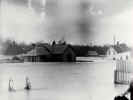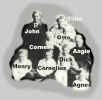|
by Henry Slotemaker Part Four---Born American
In July of 1900 the First Christian Reformed Church of Lynden was organized. 2As they were members of the C.R.C. in Orange City, they transferred to the Lynden church upon their arrival here in December of that year. From the beginning they took a very active part in the work of the church. Dad served many years on the consistory or council, taught Sunday school and catechism classes and for a time was leader of the young peoples society. In the absence or illness of the pastor he frequently led the services, reading a published sermon. 3 Mother was a charter member of the Ladies Aid Society in which she took a very active part, frequently serving on the executive committee. They practiced the hospitality on the frontier. I can remember several individuals and families who upon their arrival in the community either as visitors, or with the purpose of settling here were welcomed to stay in our home until they found a place to live. When Agnes was about one year of age mother took her along on a trip to Iowa to visit her parents and family, staying away most of Sept. and Oct. Although I was less than three years of age at the time, I can faintly remember it. We two boys would spend the days with Grandpa and Grandma, the nights at home. It should be noted here that in 1904 or 1905 the Henry Spaan and Peter DeVries families came to Lynden and established their homes here. This place by the river was of some historic significance for the Lynden Community. Before there was any semblance of a road between Bellingham and Lynden, or the river bridged, a small freight and passenger boat came up the river to a point on this place where a wharf was built. This facility is said to have made a valuable contribution to the early progress of the community. A trestle spanned the marshy area between the river bank and the high ground which is Lynden. I do not remember the wharf as it had been destroyed by a flood before my time, but we did use the trestle for walking over, but it was no longer safe for horse drawn traffic. There was also a large gravel bar by the river. This gravel was excellent road building and concrete making material. Soon the trestle was removed and a gravel driveway built, which has been maintained until the present day. There is no way of estimating the amount of gravel that has been taken from that bar, but it must run into millions of yards. Until about 1930 almost all of the gravel (and much of it since that time) used for building of streets and buildings in and near the town of Lynden came from this bar. In 1914 Lyndenís Front St. was paved from 1st St. to B.C. Ave. and 3rd St. to the depot. Before that time the mud could be deep on the streets in the winter, especially during a thaw, and in the summer the dust was almost as deep. To emphasize this the story was told that in front of the livery stable on the south side of Front St. (at 5th) was a large puddle on which the men on the board walk in front of the stable saw a hat floating. One of the men took a long stick trying to retrieve the hat when a hand reached up from below it, and a voice was heard saying, "Thatís my hat!" and the wearer was standing on a load of hay. This story may not be true in every detail but it does illustrate a point.
Another memory worth recording is the large numbers of salmon caught in the river by means of dip nets. Dozens of men lined the river bank during the fall of the year when salmon came up to spawn. Most numerous were the Dog salmon or Chum which were considered worthless, and were left on the bank, sometimes dozens, perhaps even hundreds. At an average weight of about 10 pounds, thatís a lot of fish. I donít know what became of all those carcasses. Dad fed a few to the chickens. Large flocks of crows and seagulls disposed of many, but with all the miles of river to patrol those scavengers had more than they could handle. Many Silvers and Steelhead were also dipped until all netting of fish in the river was prohibited by law. Dipping salmon was no job for small boys but seeing all those fish stimulated our desire to do some fishing of our own. Cutting a willow stick, attaching a hook, line and sinker and using worms for bait, we were in business. With this primitive equipment, we caught many a trout, and perhaps a great number of suckers and bullheads. I should also mention the small lake about an acre in size that was partly on our place. It was spring fed, this spring also being our source of domestic water supply. A rather deep channel connected the spring to the lake. This channel was about 50 feet long and from 10-20 feet wide with varying depths up to perhaps 10 feet. It was partly shaded by trees, keeping the water quite cool even in summer. This channel also yielded many a trout. The lake abounded with chubs, a small chubby fish seldom more than six inches in length. These were easy to catch and Grandma was very fond of them. We brought her many a mess of chubs. The lake was also a popular swimming hole for several boys from town. When speaking of Northeasters, we usually think of those that came in the winter, but we experienced some summer Northeasters that were more uncomfortable and devastating than those in winter. In winter it was possible to escape the worst of the storm by going inside by the fire. Not so in summer. The first on I recall came in July. Vedder Lake, about 10,000 acres of marsh a short distance north of Sumas in B.C. was the home of one of the worldís most prolific species of mosquito. When this northeaster came along huge clouds of mosquitoes drifted along for a free ride, nor did they stop at the border, they kept right on. By the time they reached Lynden they must have been very hungry; at least it seems they all swooped down at once to attack the unsuspecting populace. Fortunately the wind lasted only a couple of days, and because the mosquitoes life span is short, we survived to tell about it. Vedder Lake has been drained, and is now excellent farm land. The second summer Northeaster that I remember was in Sept. 1910, a few days after school started. There had been little or no rain for a few weeks and the woods were tinder dry. Soon after this Northeaster started a cloud of smoke was seen to the N.E. of Lynden. Everyone knew what that meant. The fire would soon reach the town. School was dismissed. Almost every able bodied adult, and young person joined to fight the fire. Most of the area east of 3rd St. and north of Grover was still wooded containing dead and rotting forest debris. Sparks were carried by the wind for long distances starting fires on unexpected places. We found a live spark that had blown all the way across town landing on our yard. I do not remember how long the storm and the fire hazard lasted, but the town was spared. Some individual buildings in the path of the blaze were destroyed. I believe that here was a clear demonstration of Godís protecting providence. If this storm carried mosquitoes with it they must have smothered in the smoke. I mentioned earlier in this narrative that in Orange City, Iowa the classroom language in school was English and the playground language Dutch. This was not an isolated incident, but reflected the ethnic group of which they were a part. It seems that many of the immigrants coming to America from Europe and Asia tried to transplant their culture into America. To do this it was necessary to preserve the use of the language. They also took with them their religious customs, traditions and convictions. Not until after World War I was much progress made in bringing about a more unified culture that could be called American. And even then the progress was painfully slow in some ways, and in some communities or families. Now this was not all bad but it did occasion some unhappy experiences. It was in this environment that we as a family grew up. Although Grandpa and Grandma were 42 years of age when they came to America, Grandma never learned to speak English, and Grandpa barely enough to be able to communicate. As children we never spoke English to our grandparents. Even Mother and Dad spoke only Dutch in the home until after their first son started school, and it was in school that he learned his first English. And he learned it quickly, not only because of native ability, but also the pressure of necessity. I often think of how fortunate I was that it was he and not I who was the eldest in the family. He was bold and aggressive, while I was shy and timid, and the agony of the first year in school might well have left permanent scars had it not been for my older brother who led the way. By the time I started school I had many a lesson in English from him. The foregoing must not be understood to imply
that Mother and Dad totally neglected our education in the home. They
perhaps assumed that they were not qualified to teach us English and
that in school it would be taught better. In this they may have been
correct, but a little English, thought faulty would have been better
than none. Is must be said to their credit that they taught us to read
Dutch; the textbooks being a childís story Bible and Sunday school
lessons. So we were able to read before we started school it should
also be Footnotes 1. The birth certificate of Cornelius Slotemaker asks some interesting questions that likely are not on current day birth certificates. 2. a 1914 photo of the men of the First Christian Reformed Church of Lynden, including John and Cornelis Slotemaker. 3. Eleanor Estie Zylstra, daughter of Agnes Slotemaker Estie, recorded her memories of the First Christian Reformed Church of Lynden and her grandfather, John Slotemaker. Continue to Part 5---The Slotemaker Farm
|




